
After the sharp falls experienced by the most diverse sectors of activity in 2020 as a result of the measures to mitigate the pandemic, 2021 began with high expectations on the part of consumers and companies who, according to the REDUNIQ Insights knowledge solution annual reportIn the end, they were confirmed at the end of the year.
Although January and February 2021 (a time of general confinement) were marked by a drop of 15% and 26% respectively in the total turnover of Portuguese businesses compared to the same period in 2020, the year-on-year change in turnover entered positive territory from March onwards, reaching a peak of +57% in April.
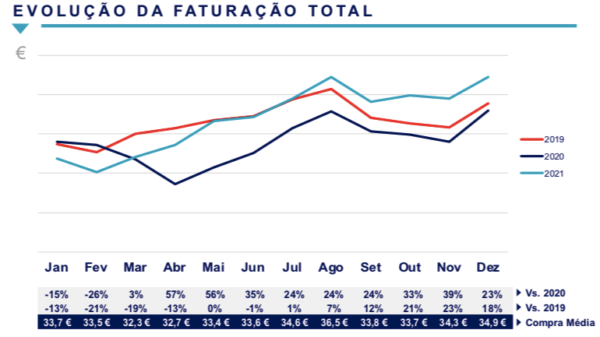
In terms of "real" recovery compared to the pre-pandemic period, this only took place from July onwards, with the peak occurring in November (23%). 2021 ended with accumulated turnover growth of around 22% compared to 2020.
In this field, special mention should be made of invoicing from the contactless payments which last year achieved an exceptional performance of 126% above the figures recorded in 2020.
National Invoicing continues to be the "engine" of the economy
As we noted in previous reportsSince the pandemic took hold of the country and slowed down tourist activity, national turnover has continued to be the "engine" of the Portuguese economy.
According to the REDUNIQ Insights annual reportHowever, domestic turnover recovered more quickly than foreign turnover (since April it has exceeded 2019 levels), due to the health requirements imposed throughout the year.
However, since last summer, tourist activity has been on the rise, with an increase of 175% in November 2021 compared to the same period last year and 15% compared to the pre-pandemic period in 2019.
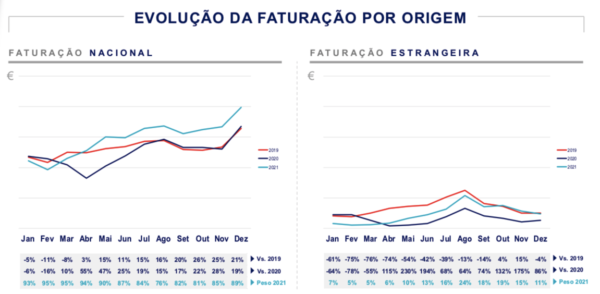
After falling to a minimum of 5% in February and March 2021 compared to the pre-pandemic figures, the weight of foreign invoicing has been approaching 2019 levels over the past year, peaking at 24% in August (in 2019 this figure was 30%).
Big cities recover more slowly
Large cities where the teleworking regime was more evident, or territories where tourism was more expressive, recovered more slowly.
The first quarter of 2021 ended up being marked by negative year-on-year variations in almost all districts, with the country as a whole recording a drop of 13% compared to 2020.
With the greater openness of the economy that followed the more severe restrictions in January and February, the 2nd quarter of the year saw a recovery compared to the same period last year, with the country as a whole recording positive variations of 48% in this period, followed by recoveries of 24% and 31% in the 3rd and 4th quarters respectively.
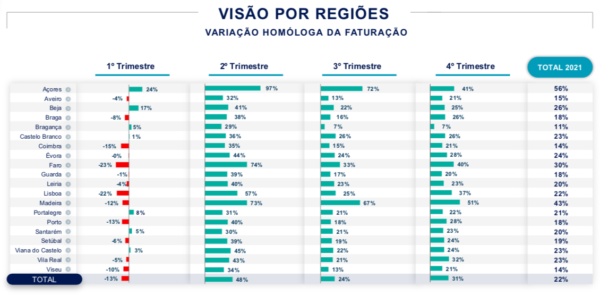
Overall, in 2021 (in accumulated values) there was a growth in total turnover compared to 2020 of 22%, with the Azores, Madeira and Faro regions registering a relative performance of more than 30% (Azores - 56%, Madeira - 43% and Faro - 30%).
Turning to the "foreign invoicing" item, it was noted that both the Azores and Madeira regions, due to having experienced a more controlled pandemic situation, showed greater growth in both foreign and domestic invoicing levels.
When we analyse the evolution of foreign invoicing in the Azores during 2021, there is a change in foreign invoicing of 129% compared to the same period last year, while in Madeira the change in foreign invoicing was 97%.
These were the regions that grew the most in 2021 compared to 2020.
In general terms, the regions with the highest tourism (Azores, Madeira, Porto, Lisbon and Faro) started 2021 with a share of foreign turnover well below 2019 levels, but by the end of the year they had managed to practically reach those pre-pandemic figures.
In the particular case of the Faro district, the report even indicates that the region recorded a year-on-year growth of 50% in foreign turnover, which even surpassed 2019 levels from October onwards.
As for the country's capital, there was a positive year-on-year change of 22%, similar to what happened in the country as a whole, and it even recorded figures higher than 2019 from September onwards, with a peak change of 21% in November.
Porto, on the other hand, recovered to pre-pandemic levels earlier (from May onwards), with a positive year-on-year change of 18% at the end of the year
Hotels & Tourist Activities and Restaurants on a growth path
Having overcome some of the constraints on economic activity seen in 2020, the different sectors have been recovering their activity throughout 2021, even those most affected by the pandemic in 2020, namely the Hospitality & Tourist Activities, Fashion, Perfumeries and Restoration.
As these sectors were among the hardest hit in the first few months of the pandemic, it turned out that some of them were the sectors with the biggest change in turnover compared to 2020 (hotels grew by 61% and restaurants by 59%).
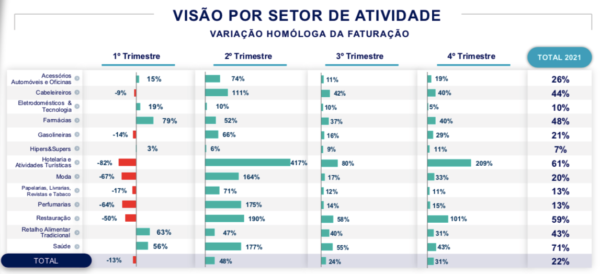
When we compare the average turnover of all categories, by point of sale, in 2021, we see a growth of 13% compared to the same period last year with the categories where there was the greatest growth in the dematerialisation of payments (contactlessfor example) such as the Restoration and hairdressers.
Conversely, the Hyper & Supers sector was the only one with a drop in average annual turnover per point of sale (-2%).
When we analyse the year-on-year evolution, by month, of each sector, we can conclude that the only ones that suffered a drop in average turnover per point of sale in April were Household Appliances & Technology (-32%), Traditional Food Retail (-17%) and Hyper & Supers (-3%).
This is because they were one of the only sectors to grow at the start of the pandemic, namely in April 2020.
Contactless accounted for 71% of transactions in December 2021
As we've already touched on throughout this article, contactless technology is increasingly important for invoicing Portuguese businesses.
According to REDUNIQ Insights reportthe weight of the Contactless has been growing month on month over the last two years, rising from 10% in January 2020 to 53% at the end of last year.
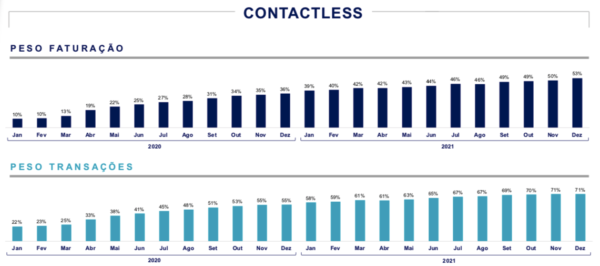
The importance of contactless payments for the recovery of Portuguese businesses is even more visible if we look at the transactions carried out over the past year. If in January 2020, 10% of the total turnover of Portuguese businesses was due to this contactless technologyIn December 2021, the contactless payments already accounted for 58% of total turnover and took part in 71% of transactions.
This consolidation of contactless payments proves that the Portuguese are increasingly embracing new ways of paying based on the use of smartphones or wearables.
These new consumer habits of the Portuguese are therefore "imposing" on businesses the need to adjust their offer in terms of means of payment.
Realising this need, REDUNIQ is helping these businesses through the technological development of automatic payment terminals (TPA), such as the REDUNIQ Smart Android automatic payment terminal which, in addition to allowing a physical shop accepts contactless card payments with card, chip, MB WAY, Google Pay and Apple Pay, incorporates a set of management apps that help businesses and allow them to be totally mobile and digital.


